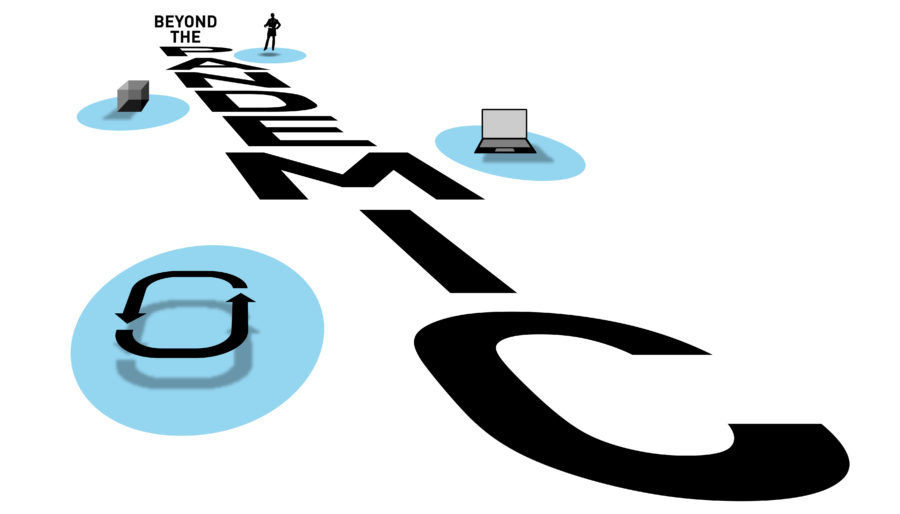Insights
May 14, 2020 _ insights
Beyond the Pandemic: A Long-Term View of Healthcare Environments’ ‘New Normal’
Social media healthcare channels and email lists are bursting with articles on ‘surge planning’ and invitations to online discussions about the post-pandemic return of patients. While valuable, what is only beginning to emerge from these discussions is a longer view understanding of what ‘the new normal’ looks like for healthcare facilities. It’s important to be prepared for the next pandemic. It’s also important to make patients and staff feel comfortable as they return to your facilities for less urgent procedures – there’s strong evidence of their anxiety about coronavirus is preventing people from even seeking emergency medical care. But what does the ‘new normal’ look like in a longer view? What will be the enduring impact of the COVID-19 pandemic (and the existing trends it has catalyzed) on ambulatory clinics and medical office buildings?
As healthcare systems emerge from the initial effects of the pandemic and begin the process of reoccupying their ambulatory facilities, we expect two significant forces to shape these spaces’ ‘new normal’:
- Renewed Anxiety & Safety Measures – The pandemic will leave a lasting impression on the nation’s psyche, shaping patient anxieties and expectations while accelerating longer-term changes to the operations of clinics and healthcare systems. The built environment will need to maximize patient safety and ease anxieties related to virus exposure in a post-pandemic world.
- Virtual Health – Foremost among the changes accelerated by the pandemic has been the widespread adoption of virtual health practices. The Cleveland Clinic alone logged more than 60,000 virtual visits in March – a 1,700% increase from the previous month. As patients, consumers, and healthcare providers are increasingly comfortable with virtual care, what will be the impact on the built environment?
While market demographics, access to emerging technologies, and capital funding will shape each healthcare system’s unique response, we see two broad planning and design considerations that can help better position a system’s ambulatory care facilities for the changing dynamics of the healthcare landscape.
Our broad recommendations:
01: Identify new pathways for patient flow.
02: Invest in standardized and flexible spaces.
Health systems that seize the moment and leverage these design strategies will best position themselves to ensure patient satisfaction and volume growth within the new dynamics of the post-COVID ambulatory care world.
01. New Pathways for Patient Flow in Ambulatory Care Environments
Upon returning to post-COVID healthcare environments, patient expectations will be very different from just a few months earlier. Post-COVID ambulatory patients will bring with them a heightened awareness of social distancing norms and, in many cases, a higher level of anxiety related to potential exposure to infections. Additionally, many of these patients will be more familiar – or at least been exposed to – digital technologies and virtual care practices that are shaping the health system’s digital front door. On the design and operations side, we expect to see changes to the way that patients arrive, register, and move through ambulatory care and medical office building environments. These process changes can be supported, in turn, by design strategies that accommodate efficient new pathways and increase patient and consumer confidence in the safety of the healthcare environment.
The Digital Front Door
As consumers become more comfortable with digital healthcare, now is the time to help define their expectations as they transition between digital and physical environments.
Widespread adoption and use of existing technologies like online registration and check-in is poised to make the experience of entering any physical, ambulatory care site at least partially digital. Significant changes to the processes of pre-registration, arrival, check-in, and waiting are already underway and will continue to be transformed as patients become more comfortable with existing and emerging digital tools. Building design solutions will need to accommodate these changing processes immediately:
- Front Door Screening Spaces: Tomorrow’s ambulatory patients will be accustomed to being greeted at the front door and given a temperature check and patient safety assessment prior to entering the building. Dedicated screening spaces adjacent to the building entrance can help to maximize the efficiency and effectiveness of this process. More than just a vestibule, these screening spaces could allow multiple patients to be screened simultaneously while adhering to social distancing requirements and providing distribution points for personal protective equipment. When screening is deemed unnecessary, this space could be used for valet service, wheelchair storage, or possibly small-scale retail (e.g., a coffee cart).
- Registration Kiosks: Kiosks at clinic registration are becoming more common but they are yet to be widely adopted in many areas of the country. With smartphone registration and self-rooming practices on the horizon, some questions remain regarding the long term need for kiosks. But it’s reasonable to assume a near-term increase in kiosk use as patients become more familiar with the technology and more inclined to avoid lines and crowds associated with traditional face-to-face registration desks. To facilitate increased patient use of kiosks, systems will need to develop strategies to ensure accessibility, privacy, and access to power and data. It will also be critical to provide easy access to cleaning and sanitation supplies next to kiosk stations.
- Waiting Rooms: While smartphone check-in and self-rooming clinics will likely decrease the amount of space dedicated to waiting rooms, it’s unlikely that these spaces will disappear from ambulatory clinics altogether. Where larger waiting rooms pose challenges for social distancing measures, owners and designers can subdivide these spaces with furniture and modular partitions to enforce seating arrangements that comply with safe distancing requirements.
- HVAC Systems: HVAC systems within waiting areas also deserve special consideration. Designing mechanical systems that allow waiting areas to be switched to negative pressure or to increase the amount of outside air during times of heightened concerns about airborne viruses can help minimize the risk of transmission and increase visitor and staff confidence in provider’s safety protocols. The benefits from this type of system design would need to be evaluated against the cost premium for construction and life-cycle operations. However, increased operating costs could be mitigated if the system is designed to switch between normal and pandemic modes.
…we expect to see changes to the way that patients arrive, register, and move through ambulatory care and medical office building environments.
Single Direction Patient Flow
In addition to developing new, digital front doors, owners and design teams of ambulatory care facilities should also look for opportunities to establish ‘single-direction’ paths of patient travel through their spaces. This can streamline the flow of patients throughout the building, making it easier to maintain social distancing norms while avoiding bottlenecking in high-traffic areas like building entrances, elevator lobbies, and clinic suites.
To maximize the impact of single direction travel, consider these strategies that combine operational processes and building design responses:
- Building Entrances: Instead of a single, combined entry/exit, design dedicated patient entries and exits to separate incoming and outgoing traffic.
- Vertical Circulation: Dedicated “up” and “down” elevators and stairs can help maintain appropriate social distancing measures in normally crowded elevator lobbies and in public stairways.
- Clinics: Travelling from clinic registration to exam room and back out (ideally, through a separate door), will minimize the possibility of crossing paths with other clinic patients and visitors.
While strategies like these will minimize exposure to infectious diseases, it’s important to note that they will likely involve an increase in square footage and building cost. Owners and designers will need to evaluate these strategies for feasibility, cost, and long-term impact to determine whether they are the right solution for specific ambulatory care sites.
02. Virtual Care & Standardized, Flexible Design
With the dramatic growth of virtual health during the COVID-19 pandemic, it’s hard to imagine telehealth doing anything other than growing in importance in the near and long-term future. While the ultimate impact of telehealth on ambulatory care environments is impossible to predict, the effects of widespread virtual and telehealth adoption will likely be seen in changing patterns in treatment timelines and in-person clinic visits. Near-term planning and design decisions will have a lasting impact on healthcare systems’ ability to respond to these evolving patterns, so it’s important to prepare these changes – even if they cannot be fully predicted.
Given that we’ll likely see changing configurations of virtual and in-person care in the coming years (in different regions, among different populations) and a changing distribution of needs for different types of in-person clinical visits, flexibility will be key. Now is the time for owners and designers to position their ambulatory sites to adapt to the changing patterns and demands of a healthcare market that is shaped by telehealth. We see design strategies focused on flexibility and standardization as the best way of approaching clinic design and maximizing responsiveness to these dynamic industry forces.
Modular Clinic Design
Modular, standardized, and universal designs will provide the most future-proofed way of responding to changing clinical space needs. While widespread adoption of virtual health could lead to a decrease in in-person visits for certain practice types, it is just as likely that other specialties will see volumes remain steady or even grow. System and market-wide standardization of clinical spaces and exam modules can ease the relocation of practice groups to right-sized spaces within an ambulatory network’s existing locations and minimize the impact of expansion and renovation projects. Standardized planning modules can also better accommodate the conversion of clusters of exam rooms into specialty procedure room types. This is important because even with an increase in virtual health visits, specialty testing and procedures will largely still need to occur within an in-person clinic environment.
Flexible Floor Plans
Flexibility can also be planned for at the building-scale. Locating major building infrastructure like elevators, stairs, public restrooms, and electrical and data rooms away from the center of a building can help achieve uninterrupted floor plates within the building footprint. Regular structural column grids, designed to maximize grid spacing within an efficient steel structure, can also contribute to that flexibility. This flexibility will position ambulatory buildings to allow for clinic renovation and reconfiguration in response to the changes brought on by the rise of virtual health.
Today’s Clinic, Tomorrow’s Hospital
Even if the rise of virtual health prompts a significant reduction in in-person clinic visits, a system’s ambulatory medical office buildings – especially those located within 250 yards of inpatient hospitals – will always maintain critical value as future inpatient or specialty clinic locations.
Future-focused owners and designers should carefully consider the impact of increasing the occupancy of their ambulatory clinics and medical office buildings while constructing them to accommodate future inpatient use. This strategy would increase the cost of construction and ongoing regulatory and maintenance lifecycle costs, but this should be weighed against the rising costs of inpatient healthcare construction and your healthcare system’s future needs.
—————————————
Mickey LeRoy is a healthcare project manager at GBBN. Recognized as an emerging leader by AIA Cincinnati’s VISION program, Mickey leads teams in all phases of planning, design, and delivery of multi-faceted healthcare projects. His work includes TriHealth Harold M. and Eugenia S. Thomas, Comprehensive Care Center, UPMC Shadyside (Renovation), and Mercy Health Deerfield Medical Center.






